Even though we don’t deal with them every day, snakes are an important part of our planet’s life. They are different from any other animals we know and many people are extremely afraid of them. The fear is natural and many times welcomed, as snakes use venom to defend their own skin when they feel attacked. They’re biorhythm is completely different in comparison to ours because they have cold blood, making them very susceptible to temperature changes which is why you don’t see them if you live in the city.
[the_ad_placement id=”in-text-1-type-r”]All this snake discussion has a meaning as today we’re going to talk about the snake trap. Even if you’re not a passionate outdoors man you may need to know how to trap a snake and what to do with it after you actually caught it.
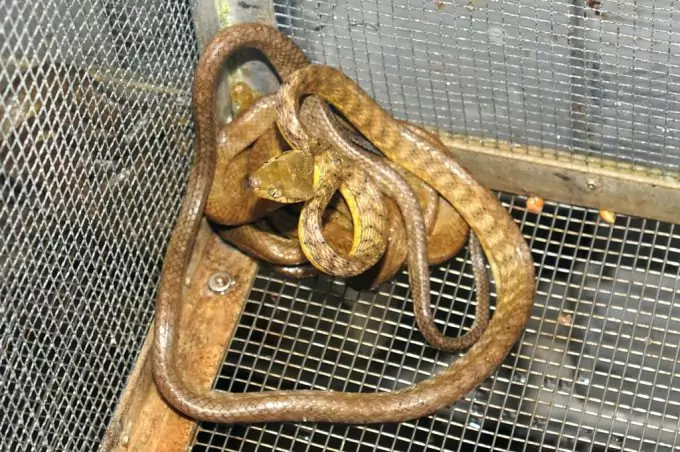
If you live in a house, then you may meet them in the garden, lying in the sun, waiting to get warm. Also you can find them in your basement, where it’s humid and cold or in holes in the foundation. They prefer tight, dark and humid places and feed with small animals like mice, baby birds, eggs, and others.
There are many scenarios where you get to interact with a snake in its natural habitat but the ones that may lead to snake trapping are the following:
- The snake decided that your garden is really good to make a house there and now you see it almost every day. If you have children playing in the yard, the snake may scare or hurt them;
- You raise chicken in your backyard but lately, they’re fewer and fewer. After a thorough investigation you realize that a snake loves your chicken more than it should;
- You go in the basement to look for something but you realize that it’s been occupied in the mean time. A snake feels like home there;
- You own a small snake and it escaped while you weren’t looking (they are extremely elusive) and now you need to catch it back;
- You need to process some snake venom for your experiments (the venom is actually useful in medicine);
- You’re in the wilderness with nothing to eat and the only living thing around are snakes.
Regardless of the reason, snakes are smart and you need to outsmart them if you want to catch them. We’ll talk about how to make a snake trap and how to handle them once they are in the trap. Make sure to not harm them unless they get extremely violent and threaten your life. If you want to get rid of a snake that causes you damages all you need to do is to relocate it.
Remember that a homemade snake trap is for small snakes. If you happen to meet a gigantic snake don’t try to approach it without professional supervision! The big ones are not dangerous because of their bite; they simply wrap around you and squeeze you until you can’t breathe anymore.
If you want to set up a trap for a small snake, we also have a great article on booby traps that may be of help so don’t forget to check it out.
How to trap a snake that set house in your garden
There are several types of homemade snake traps that you can build using simple materials and your spare time. We’re going to talk about the most used ones in trapping small snakes. The main idea with a snake trap is to get the snake inside the trap and convince it to eat the bait there.
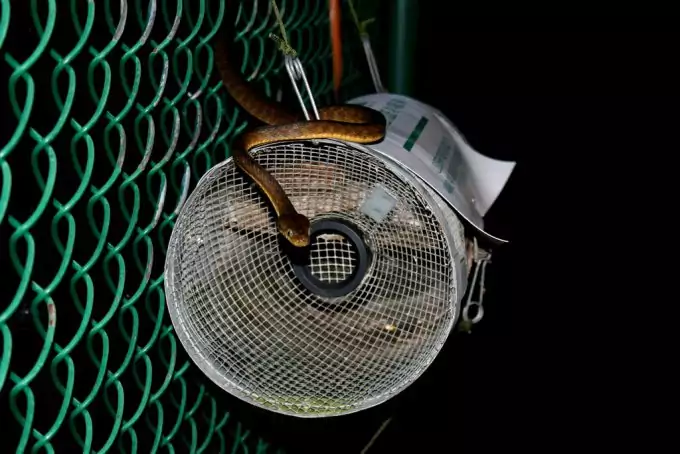
A snake doesn’t chew it’s pray, it swallows it and then sits tight to digest it for a few hours (talking about small snakes). Big snakes swallow bigger prays which means that they will have a longer digestion process. If the snake eats the bait inside the trap it won’t be able to come out the same way it entered because its body will be rounder (if you build the trap correctly).
How to make a snake trap for your pet
If your pet snake escaped and you miss it, you should try to build a basic homemade snake trap to find it. Still, there’s no assurance that what you’ll catch is going to be the snake you’re looking for.
You will need the following items:
- a plastic bottle from juice washed, rinsed and dried;
- a pair of scissors;
- a frozen mouse that you use to feed the snake.
Take the bottle and make sure that it’s clean so there are not other smells coming from it. Use the scissors to cut a small hole in it (enough for the snake to come in) and put the bait inside the bottle. Put the trap in a place where you consider your snake might have hidden and wait. If the snake comes inside and feeds, it won’t be able to come out through the small hole. Make sure to check the trap every few hours.
The wooden box snake trap
If you have a wild snake on your property or worse, somewhere inside your house it’s time to bring out the bigger guns. The wooden box is efficient if you’ve identified the place of the den. This box trap is quite difficult to build by your own so we recommend to look for it in a specialized shop.
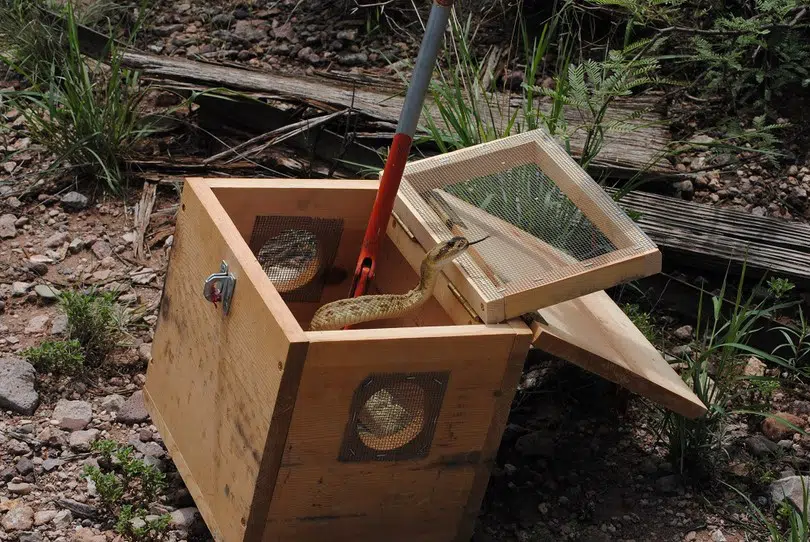
The main idea is to put it over the den entrance so when the snake / snakes try to leave the den they will enter the box. As the snake enters, the box closes keeping the snake inside. Now you can take the box far away from your home and release the snake in the wilderness. They won’t come back and you’re happy to get rid of them. Problem solved!
Funnel door wire cage snake trap
If you don’t know where the den is but you know where the snake likes to hang out during the day (they love the sun) you can make a funnel door trap using some wire. You will need some wire, wire cutters, and something to help you keep everything together. The trap is easy to make following three simple steps:
- First make a cylinder out of the wire with a diameter of about 10 to 20 cm according to snake’s size.
- The second step is to make a funnel out of wire. The small hole should be big enough so the snake can get through while skinny but small enough so the snake can’t go out after it fed.
- The third step is to put everything together and seal the end without the funnel with more wire.
This trap is very similar to the one made out of a plastic bottle. The only difference is that you can catch bigger snakes with it.

Image credit: wideopenpets.com
Also, if you really want to convince a snake to go in, you should use living bait like mice or big insects. The movement and the smell of live pray attract snakes more than dead animals or food. Now, place the trap where you think the snake likes to take its morning walk and wait for it to go inside. Check the trap regularly because once a snake devours its pray it becomes skinny again and it will get out of your trap.
If you need visual aids on how to build the trap, here is a video tutorial on how to make a snake trap out of wire.
Glue traps for snake
This type of trap is very common and efficient and many people prefer it. You can usually find it in specialized shops or you can ask your local exterminator for one. The glue trap is actually a box with bait in it and filled with some sort of special glue on the bottom.
The innocent snake comes in to eat something good and, it suddenly realizes it can’t get out anymore because of the glue. The glue won’t hurt the snake, it will simply keep it there until you get to the trap. Make sure you check your traps regularly because, if you leave the snake there for a few days, it might die of starvation and you’ll have an innocent soul on your conscience.
[the_ad_placement id=”in-text-2-type-r”]When you choose the trap, make sure it is big enough to fit the snake you want to capture. If it’s too small, the snake might get away with it. Because he won’t be able to free from the glue it might die somewhere in the garden. Again you will be the one with a guilty conscience.
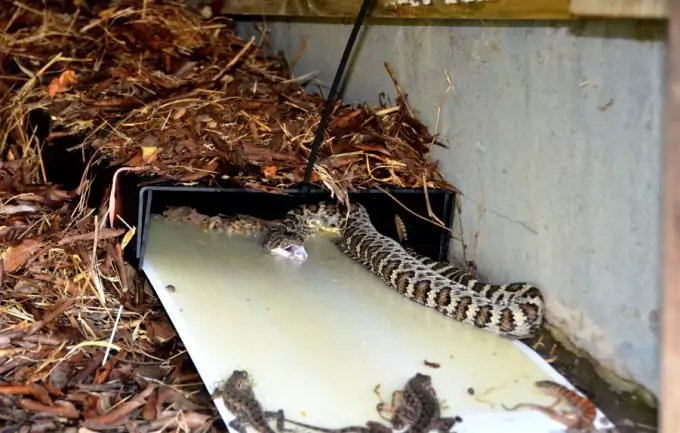
Once you manage to trap the snake, take the box somewhere in the wild where there’s a lot of grass and no one would be bothered by the snake’s presence. Pour some oil into the glue and wait for the snake to get free from the trap. Now you can be satisfied with yourself: you freed the snake in a friendly environment and you managed to get rid of a predator in your yard.
How to handle a snake once it is trapped
The first rule when trying to trap a snake: don’t touch it! Unless you know what type of snake you’re dealing with and you have worked with snakes before, don’t even think about touching it. They may look cute and helpless but remember: they are not pets! Also, the one you just trapped might be venomous so stay away from the fangs. We have a great article on the most dangerous snakes and you can try to identify your snake based on the information there.
A wild snake doesn’t like to be touched and handled at all so it might get violent and bite you as you try to free it. In case this happens go straight to the hospital. It’s true that there are several non-venomous snakes out there but if you’re not sure it’s not worth the risk. A snake bite, beside the fact that it hurts really bad, it can stop your heart.
Once you have the snake in the trap, don’t try to poke it or shake it. They don’t like it at all and you’re only infuriating it. Also, don’t let small children or pets around the trap while the snake is inside.
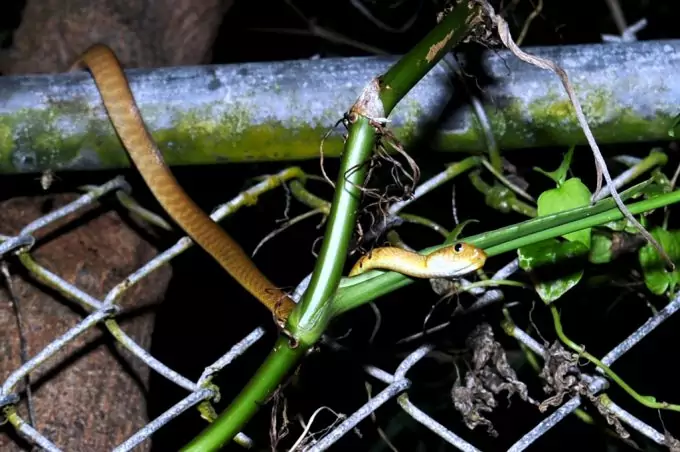
The first thing you have to do once you caught a snake is to carefully lift the trap, put it in your car somewhere safe and drive to a place where you can release the snake.
A snake knows its territory so try to drive at least 2 miles away from your house. If you free it too close to your house, it will find its way back and it might get there even before you do. Try to look for a place where there are no other houses nearby; you don’t want someone else to go through what you just did, do you? Also, if you leave it in a populated area the next person it disturbs may not be as understanding as you. If you went to all that trouble at least make sure the snake will be safe.
How to free the snake
This part is a bit tricky because you don’t know how the snake is going to react when you open the snake trap. Most of them are incredibly happy to be free again and they’ll get lost in the grass looking for a new place. Still, there might be some that will turn on you, which is why you need to be prepared. Wear thick gloves and long pants so you’ll be protected in case the snake makes a quick turn and strikes. Watch it carefully and try to keep your distance from the trap as much as possible.
After the snake is released, follow it with your eye sight as long as you can to make sure it doesn’t come back for revenge.
A snake trap is usually created for two purposes: to trap the snake and to set it free. According to type of trap, there are different ways of setting free a snake:
- If you’re using a wooden box, just put the box in the grass and lift the lid. Move away from the snake’s way and wait for it to leave the box. Don’t rush it and don’t poke it with a stick. Snakes have the ability to jump at their pray so if it sees you as a threat it will turn on you;
- If you use a funnel wire cage you’ll be a little closer to the snake, which is why we recommend wearing thick gloves. The first rule stands: don’t touch it! Easily retract the funnel wire out of the cage and let the snake decide when it wants to come out. It won’t take long.
- With the glue trap, you need to pour some vegetable oil on the snake’s body and wait for it to get free out of the glue.
If you feel the snake looks for revenge, make sure to move away from its path and try to keep it at distance. Don’t kill the snake unless you absolutely have to.
How to trap a snake in the wilderness
Trapping a snake for dinner in the wilderness can be a very dangerous job and it is not recommended unless you know what the snake ate. The main danger here is what the snake had for dinner before you eat it. If it ate a poisoned mouse or something highly toxic, it will impregnate in the meat and enter your organism. If you’re sure the snake is clean, you can use your survival skills to trap it.
[the_ad_placement id=”in-text-3-type-r”]In the wilderness there are no wires or specially designed snake traps so you have to either learn how to make a snake trap out of twigs and grass or to simply use a stick. The stick part works very well with nonvenemous ones but if you’re agile enough you can trap any type of snake. Once you’ve spotted the snake, approach with care and use a long stick to distract the snake’s attention. Move one end of the stick in front of its eyes while keeping your distance.
Once the snake is focused on your stick, firmly grab its tail and pull it up just enough to leave its head close to the ground. Now the snake is disoriented and it’s your time to act further. Put the stick at the half of the snake’s body and lift it up, while you still keep the tail in one hand. Now you have the snake in half on your stick and you can transport it to the place where you want to cook it.
Snake trapping is not an activity for a beginner survivalist! You need to know how to move and how to react if something goes wrong and the snake turns on you.
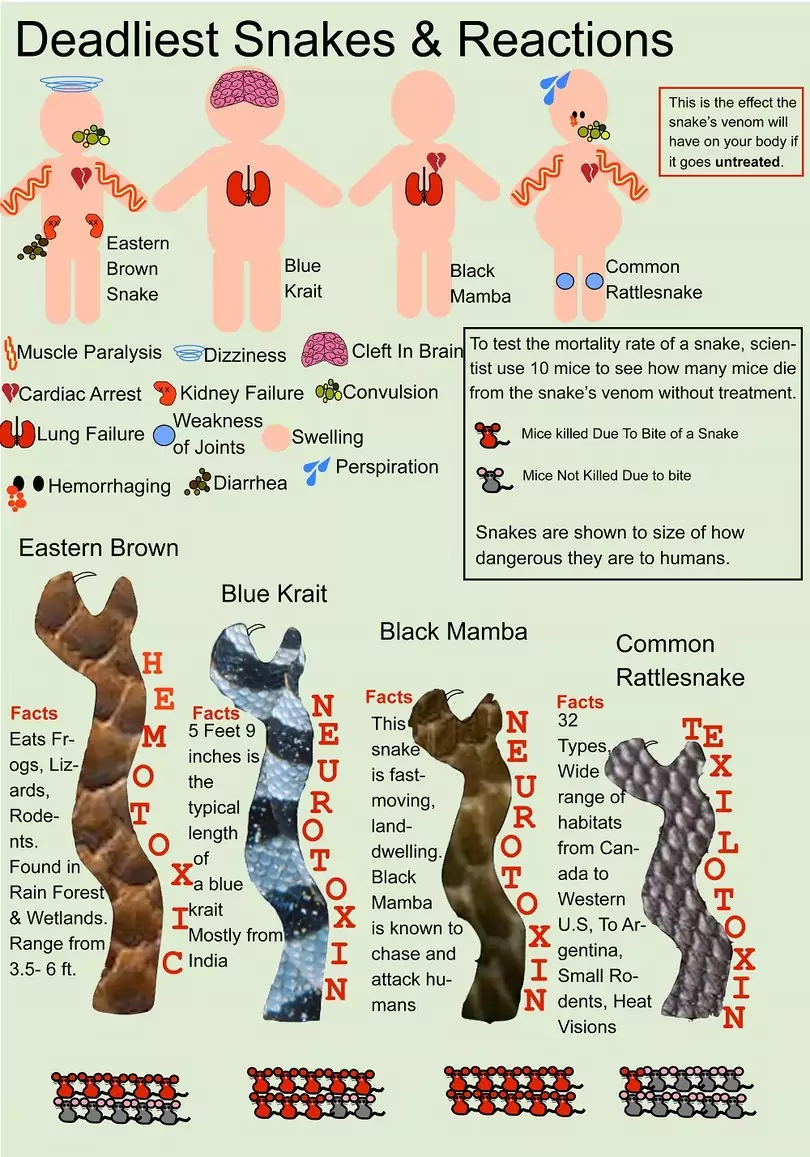
As you can see, it’s not difficult to learn how to make a snake trap but it should only be used to relocate the snake. Even if they frighten you, snakes have their job in the surrounding environment and we should protect them. Even if their skin is cold and they look different, they are also living creatures that can learn how to love a human being. So don’t make snake traps unless you absolutely need them!






Snakes are beautiful creatures; I love snakes. I have a pet snake, and it does tend to play hide and seek, a useful trick I use when the snake disappears, it that I throw soft white powder on the floor when the snake passes over, it leaves a trail and that make it easier to locate it quickly.
We had a snake get stuck on one a while back. My sibling poured lamp oil, if I remember correctly, on it and I delicately cleaned and washed it, and set it free in the garden without much harm. Hopefully that little monster endured.
Peter, lamp oil doesn’t always work with snakes and when it comes to handling them, it is always better to use the right equipment as we would not always know how they, the snakes, would react to emulsions, like lamp oils. It’s a good thing you set it back in the garden though.
Andrew
Patrick, Be careful when using powder though. Some snakes react poorly to them while some can get it stuck between their scales, causing skin infection.
Andrew
I’ve encountered quite a few snake glue traps and word of advice, hold your nose when setting them up. These traps are baits so they smell like rat. The smell is very thick, too, so unless you’re trying to catch a snake outside your home, try some other traps. Good post.
You shouldn’t shy away from snake traps, they are quite easy to set up.
I am afraid of snakes. It is not a phobia-type fear but the sight of snakes creep me out, even if they are just in pictures. This post, especially the part with homemade trap is very informative, this is the first time that I have known that a snake can’t go out after feeding. I guess you can call this a case of knowing your enemy better.
Hey Andrew, great article! How can I make sure that there is only one snake that is lurking around my property because I fear that I might be overconfident when I catch one snake only to find out that there are a lot more of them in my property.
You cannot trap snakes, if you have no idea of their behavior and routine. This article helps you to learn snakes better. However, a successful trap depends on the snake, type of trap, and location.
It depends if the area is infested by snakes, but in most cases you will trap a single snake. Snakes are lone hunters; therefore, they cannot be caught in a single trap. Consider hiring a professional snake catcher, if the area is prone to snakes.
I have been to many hunting activities and with other group of hunters. Most of the time, I see them make snake traps. There are varied sizes and styles; it basically depends on my colleague’s resources and creativity. These traps are placed in hunter decks, but despite seeing it all the time, I don’t get what its purpose is. Could you please explain it to me?
There are a lot of snake traps introduced worldwide. Though, some are quite impressive, I am still hesitant whether it will work on the types of snake we have in our farm. Never to mention that people in our place call me every time snakes evade their houses. I started making a glue trap for snakes, very basic. However it works for young snakes, but I am still in search for other traps suited for various snake types. Any recommendation for a farm set-up?
Good article on this subject. But I have one question, “How do I know if the snake is tamed or not?” If you are in a situation where you know it’s a tamed snake I believe that you can handle it more easily, because wild snakes are more aggressive than tamed ones.
Great information content. It’s important to remember that you should not let a snake die in your trap, once you catch it, you have to deal with it as quick as possible. Leaving it to die is both inhumane and unsanitary, because the snake will quickly start to rot. Remember to check your trap every day to see if something got caught in there, it can be any other animal too, if the trap is big enough.
You need an easy to use snake trap that is not only safe to trap snakes, but does also completely immobilize the snake.
Well, there isn’t a particular method of knowing whether or not a snake is wild or not at first glance. The best thing you can do prior to setting up a snake trap is learn everything about the snakes in your vicinity. Know which ones are venomous and which ones aren’t. This way, you will be confident when approaching the trapped snake.
I do recommend the wooden box snake trap and the funnel door wire cage snake trap. They are well-equipped to trap some of the notorious snakes that will sneak in to snatch you poultry.
One of the most important benefits of setting up a snake trap is catching the snake before it does you harm. Traps also help to keep snakes away from your farm.